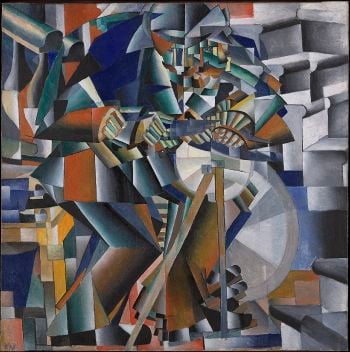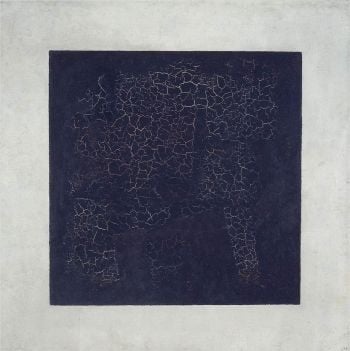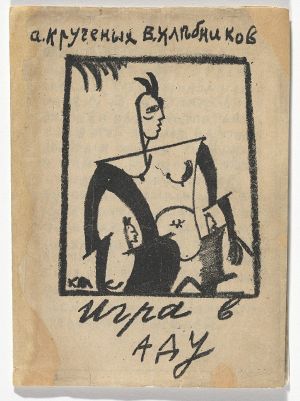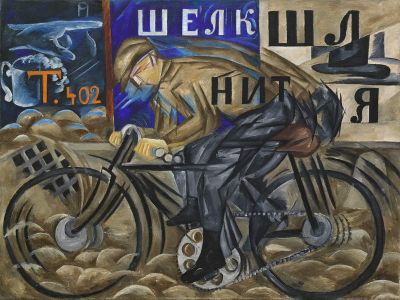Russian Futurism

Russian Futurism is the broad term for a movement of Russian poets and artists who adopted the principles of the Italian futurism, especially Filippo Marinetti's "Manifesto of Futurism," which espoused the rejection of the past, and a celebration of speed, machinery, violence, youth, industry, destruction of academies, museums, and urbanism; it also advocated for modernization and cultural rejuvenation.
Russian Futurism began roughly in the early 1910s; in 1912, a year after Ego-Futurism began, the literary group "Hylea" - also spelt "Guil√©e" and "Gylea" ‚Äď issued the manifesto A Slap in the Face of Public Taste. The 1912 movement was originally called Cubo-Futurism, but this term is now used to refer to the style of art produced. Russian Futurism ended shortly after the Russian Revolution of 1917. The former Russian Futurists either left the country, or participated in the new art movements.
Notable Russian Futurists included Natalia Goncharova, Mikhail Larionov, David Burliuk, Kazimir Malevich, Vladimir Mayakovsky, and Velimir Khlebnikov.
Artistic Vision
Marinetti's Manifesto of Futurism celebrated the ‚Äúbeauty of speed‚ÄĚ and the machine as the new aesthetic.[1] Marinetti explained the ‚Äúbeauty of speed‚ÄĚ as ‚Äúa roaring automobile is more beautiful than the Winged Victory‚ÄĚ indicating the movement towards the future.
Like their Italian counterparts, the Russian Futurists were fascinated with the dynamism, speed, and restlessness of modern machines and urban life. They purposely sought to arouse controversy and to gain publicity by repudiating the static art of the past. The likes of Pushkin and Dostoevsky, according to A Slap in the Face of Public taste, should be "heaved overboard from the steamship of modernity".[2] They acknowledged no authorities whatsoever; even Filippo Tommaso Marinetti, when he arrived in Russia on a proselytizing visit in 1914, was dismissed by most Russian Futurists, who did not profess to owe him anything.[1]
Initially the term "futurism" was problematic, because it reminded them too much of their rivals in Italy; however, in 1911, the Ego-futurist group began. This was the first group of Russian futurism to call themselves "futurist." Shortly afterwards, many other futurists followed in using the term.
Origins

The most important group of Russian Futurism may be said to have been born in December 1912, when the Moscow-based literary group Hylaea (Russian: –ď–ł–Ľ–Ķ—Ź [Gileya]), initiated in 1910 by David Burlyuk and his brothers at their estate near Kherson. They were soon joined by Vasily Kamensky and Velimir Khlebnikov, with Aleksey Kruchenykh and Vladimir Mayakovsky in 1911.[3]They issued their own manifesto entitled A Slap in the Face of Public Taste (Russian: –ü–ĺ—Č—Ď—á–ł–Ĺ–į –ĺ–Ī—Č–Ķ—Ā—ā–≤–Ķ–Ĺ–Ĺ–ĺ–ľ—É –≤–ļ—É—Ā—É).[4] The Russian Futurist Manifesto shared similar ideas to Marinetti‚Äôs Manifesto, such as the rejection of old literature for the new and unexpected.[1]
The Hylaea group included artists Mikhail Larionov, Natalia Goncharova, Kazimir Malevich, and Olga Rozanova.[5]
While many artforms and artists converged to create Russian Futurism, David Burlyuk (born 1882, Ukraine) is credited with publicizing the avant-garde movement and increasing its renown within Europe and the United States.[6] Burlyuk was a Russian poet, critic, and publisher who centralized the Russian movement. While his contribution to the arts were less than his peers, he was the first to discover many of the talented poets and artists associated with the movement. Burlyuk was the first to publish Velimir Khlebnikov and to celebrate the Futurist poetry of Vladimir Mayakovsky.[7] Russian futurism also adopted ideas from ‚ÄúFrench Cubism‚ÄĚ which coined the name ‚ÄúCubo-Futurists‚ÄĚ given by an art critic in 1913.[6] Cubo-futurism adopted ideas from Italian Futurism and French Cubism to create its own blended style of visual art. It emphasized the breakdown of forms, the use of various viewpoints, the intersection of spatial planes, and the contrast of color and texture. The focus was to show the intrinsic value of a painting, without it being dependent on a narrative.[6]
Ego-Futurism
Although Hylaea is generally considered to be the most influential group of Russian Futurism, other groups were formed in St. Petersburg (Igor Severyanin's Ego-Futurists), Moscow (Tsentrifuga, with Boris Pasternak among its members), Kiev, Kharkiv, and Odessa. Ego-Futurism was developed by Igor Severyanin and his early followers. While part of the Russian Futurism movement, it was distinguished from the Moscow-based cubo-futurists as it was associated with poets and artists active in Saint Petersburg.[8]
Ego-Futurism was born in either the summer of[9] or in November[10] that year, when Severyanin published a small brochure titled Prolog (Ego-Futurism). The first Ego-Futurist publication, it insulted contemporary verse, declared that poetry would soon have to undergo a complete transformation to suit modernity, and claimed that he was already famous throughout Russia.[10] Although a group of four Ego-Futurist poets calling themselves the "Ego-group" had already been formed that October, they only issued their manifesto after Prolog was published, beginning their activities in January the following year.
The four original members - Severyanin, Konstantin Olimpov (Fofanov's son), Georgy Ivanov, and Graal Arelsky - then issued a manifesto illustrating their intentions, now calling themselves the "Academy of Ego-Poetry."[11] The group began to hold loud public events to gain publicity, but little information is available related to these.[1] The ideology of Ego-Futurism has been described as founded on a personality cult and the poet's abhorrence of the crowd.[12]
By 1913, groups inspired by Ego-Futurism began to appear. One such group, "Mezzanine of Poetry," was founded by Vadim Shershenevich. It was dissolved by 1914, and Shershenevich joined the Cubo-Futurists.[13]
Cubo-Futurism
The term 'Cubo-Futurism' first appeared in a lecture in 1913, originally to refer to the poets who belonged to David and Vladimir Burliuk's literary group, 'Hylaea', also spelt 'Guilée'[14] and 'Gylea.'[15] This term was coined by Korney Chukovsky (1882-1969), a Russian art critic, in reference to the work of Vladimir Mayakovsky, Aleksey Kruchonykh, Velimir Khlebnikov, Benedict Livshits, and Vasily Kamensky, members of the Hylaea group. It was only after these poets began to display shocking public behavior (for example wearing absurd clothes), when the writers and the movement in general began to be called simply Russian Futurism.[15] As a result, 'Cubo-Futurism' then began to refer to the artists who were influenced by Cubism and Futurism,[6] though both terms still remain interchangeable.
The earliest appearances of the Cubo-Futurist art style can be found in the works of Natalia Goncharova, who, as early as 1909, applied Cubist and Futurist means of expression in her paintings.[16]
Thanks to modern technology (transport and telegraphy, for example) and the artists' experience of other countries, the creatives in Russia knew much about the avant-garde events in Europe. Cubo-Futurism as an art style would begin to take its full form in the years 1912 to 1913, though the style of poetry ended when Russian Futurism itself also faded.
One of the first major painters to become a Cubo-Futurist was Kazimir Malevich, who entered his Cubo-Futurist phase in 1912‚Äď13. He termed the works he exhibited at the 1912 'Donkey's Tail' and 1913 'Target' exhibitions as "Cubo-Futurist."[17] For Malevich, Cubo-Futurism symbolized the connection between the stillness of conventional Cubism, and the dynamism inherent in Futurism. Rather than simply following the example of painting industrial scenes, set by the Futurists in Italy, or of painting in fairly flat colors, set by the Cubists in France, he placed heavy rural Russian themes on his work. It led to his paintings of traditional village life in a bright, avant-garde style, juxtaposing form and content. One example of his Cubo-Futurist work is The Knifegrinder, painted circa 1912‚Äď1913.
Differences between the groups
From the beginning, there were several differences between the Cubo-Futurism and Ego-Futurism. In their almanacs, the Ego-Futurists published Symbolist poetry alongside their own, while the Cubo-Futurist poets completely rejected the past,[1] going so far as to declare that famous authors like Fyodor Dostoevsky had to be immediately "pushed off the steamboat of modernity"[2] Severyanin also decried excessive objectivity of the Cubo-Futurists, advocating a more subjective attitude. Although other Russian Futurists dismissed the Ego-Futurists as puerile and vulgar, Severyanin argued that his advancement of outspoken sensuality, neologisms, and ostentatious selfishness qualifies as futurism.
Despite their differences, the group briefly united in 1914. Unfortunately for the project, Shershenevich was involved,[18] and he took advantage of a group tour to publish, in the group journal, an attack against the Ego-Futurists and a Moscow Futurist group, "Centrifuge." Boris Pasternak, a member of Centrifuge, retorted with a satirical article against him,[13] leading to a verbal battle between certain members of the groups for recognition as the first, true Futurists.
In 1913‚Äď4, the Cubo-Futurist poets Vladimir Mayakovsky, Vasilly Kamensky, and David Burliuk decided to tour Russia with poetry recitals. Severyanin occasionally joined in, but it was during this time that the collaboration ended, due to an argument between Burliuk and Mayakovsky.[19]
Literature and Typography
In contrast to Marinetti's circle, Russian Futurism was primarily a literary rather than a plastic philosophy. Although many poets (Mayakovsky, Burlyuk) dabbled with painting, their interests were primarily literary. However, such well-established artists as Mikhail Larionov, Natalia Goncharova, and Kazimir Malevich found inspiration in the refreshing imagery of Futurist poems and experimented with versification themselves. The poets and painters collaborated on such innovative productions as the Futurist opera Victory Over the Sun, with music by Mikhail Matyushin, texts by Kruchenykh and sets contributed by Malevich.[6]
Members of Hylaea elaborated the doctrine of Cubo-Futurism and assumed the name of budetlyane (from the Russian word budet 'will be'). They found significance in the shape of letters, in the arrangement of text around the page, in the details of typography. They considered that there is no substantial difference between words and material things, hence the poet should arrange words in his poems like the artist arranges colors and lines on his canvas. Grammar, syntax, and logic were often discarded, while many neologisms and profane words were introduced. Onomatopoeia was declared a universal texture of verse. Khlebnikov, in particular, developed "an incoherent and anarchic blend of words stripped of their meaning and used for their sound alone,"[20] known as zaum.
Politics
With all this emphasis on formal experimentation, some Futurists were not indifferent to politics. In particular, Mayakovsky's poems, with their lyrical sensibility, appealed to a broad range of readers. He vehemently opposed the meaningless slaughter of World War I and hailed the Russian Revolution as the end of that traditional mode of life which he and other Futurists ridiculed so zealously. Although never a member of the Russian Communist Party (RKP(b)), he was active in early 1919 in the attempt to set up Komfut (Communist Futurism) as an organization promoting Futurism affiliated to the Vyborg District Branch of the Party.[21]
The Bolshevik Agit-trains
In the early years of the Bolshevik regime, during the Russian Civil War, Russian futurists still played a significant role in revolutionary art. One of the government's propaganda efforts was so-called "Agit-trains," designed to take journalists and other key figures to show them what the government wanted them to see.
War correspondent Arthur Ransome and five other foreigners were taken to see two of the Bolshevik propaganda trains in 1919 by their organizer, Burov. The organizer first showed them the "Lenin,"[22] which had been painted a year and a half earlier
when, as fading hoardings in the streets of Moscow still testify, revolutionary art was dominated by the Futurist movement. Every carriage is decorated with most striking but not very comprehensible pictures in the brightest colours, and the proletariat was called upon to enjoy what the pre-revolutionary artistic public had for the most part failed to understand. Its pictures are ‚Äėart for arts sake‚Äô, and can not have done more than astonish, and perhaps terrify, the peasants and the workmen of the country towns who had the luck to see them.[23]
The "Red Cossack"[22] was quite different. As Burov put it with deep satisfaction, "At first we were in the artists’ hands, and now the artists are in our hands". Initially the artists were so revolutionary that at one point Burov had delivered the Department of Proletarian Culture some Futurists "bound hand and foot," but now "the artists had been brought under proper control."[23]
The other three trains were the "Sverdlov," the "October Revolution," and the "Red East."
Cinema
Russian Futurist cinema refers to the futurist movement in Soviet cinema. Russian Futurist cinema was deeply influenced by the films of Italian futurism (1916-1919) most of which are lost today. Some of the film directors identified as part of this movement are Lev Kuleshov, Dziga Vertov, Sergei Eisenstein, Vsevolod Pudovkin and Aleksandr Dovzhenko. Sergei Eisenstein's film Strike was seen as "the mordern Futurist art form par excellence" by Olga Bulgakowa.[24] Bulgakowa theorized how the camera could change one's perceptions of reality and how it could make it seem like time was speeding up or slowing down during the film.
Demise

After the Bolsheviks gained power, Mayakovsky's group‚ÄĒpatronized by Anatoly Lunacharsky, Bolshevik Commissar for Education‚ÄĒaspired to dominate Soviet culture. Their influence was paramount during the first years after the revolution, until their program‚ÄĒor rather lack thereof‚ÄĒwas subjected to scathing criticism by the authorities. By the time OBERIU (Union of Real Art) attempted to revive some of the Futurist tenets during the late 1920s, the Futurist movement in Russia had already ended. The most militant Futurist poets either died (Khlebnikov, Mayakovsky) or preferred to adjust their very individual style to more conventional requirements and trends (Aseyev, Pasternak).[10] The decline of futurism can also be seen in Russia when Kruchenykh attempted to publish Fifteen Years of Russian Futurism 1912-1927 in 1928. The Communist Party made it clear they did not want any futurist influence in Soviet literature. This marked an abrupt fall from grace for Kruchenykh's writing and futurism as a literary movement.
Legacy
Artforms were greatly affected by the Russian Futurism movement within Russia, with its influences being seen in cinema, literature, typography, politics, and propaganda. While some significant writers (Pasternak, Mayakovsky) and artists (Malevich) were part of the futurist movement, the movement itself saw its demise in the early 1920s. It did not survive the revolutionary requirement that art and literature serve the interests of the Soviet state.
Notes
- ‚ÜĎ 1.0 1.1 1.2 1.3 1.4 Anna Lawton and Herbet Eagle, Russian Futurism through Its Manifestoes, 1912-1928 (Ithaca, NY: Cornell University Press, 1988, ISBN 0801494923), 1‚Äď3.
- ‚ÜĎ 2.0 2.1 David Burliuk, et. al., "A Slap in the Face of Public Taste," www.marxists.org, 1917. Retrieved July 14, 2023.
- ‚ÜĎ Victor Terras, Handbook of Russian Literature (New Haven, CT: Yale University Press, 1990, ISBN 978-0274733972), 197.
- ‚ÜĎ "Selected Poems with Postscript, 1907‚Äď1914," Library of Congress, 1914. Retrieved July 14, 2023.
- ‚ÜĎ Nina Gurianova, "Game in Hell, Hard Work in Heaven: Deconstructing the Canon in Russian Futurist Books" in The Russian avant-garde book, 1910-1934 ed. Margit Rowell and Deborah Wye (New York, NY: The Museum of Modern Art, 2002, ISBN 978-0870700071).
- ‚ÜĎ 6.0 6.1 6.2 6.3 6.4 "Cubo-Futurism (art movement)," Encyclopedia Britannica. Retrieved July 26, 2023.
- ‚ÜĎ "David Davidovich Burlyuk (Russian poet, painter, critic, and publisher)," Encyclopedia Britannica. Retrieved July 26, 2023.
- ‚ÜĎ Sara Freeman, Theatre History Studies 2019 (Tuscaloosa, AL: University of Alabama Press, 2020, ISBN 978-0817371135), 65.
- ‚ÜĎ "Ego-Futurism," Monoskop. Retrieved July 26, 2023.
- ‚ÜĎ 10.0 10.1 10.2 Vladimir Markov, Russian Futurism: a History (Berkeley, CA: University of California Press, 1968, ISBN 978-0520008113), 64.
- ‚ÜĎ Lenie Lauwers, Igor' Severjanin - his Life and Work - the Formal Aspects of his Poetry (Leuven, BE: Peeters, 1994, ISBN 978-9068314915), 14.
- ‚ÜĎ Rina Lapidus, Jewish Women Writers in the Soviet Union (London, U.K.: Routledge, 2013, ISBN 978-0415617628), 13.
- ‚ÜĎ 13.0 13.1 Christopher Barnes, Boris Pasternak: a Literary Biography, Vol. 1, 1890-1928 (Cambridge, U.K. Cambridge University Press, 2004, ISBN 978-0521520720), 165‚Äď166.
- ‚ÜĎ Gino Severini, The Life of a Painter trans. Jennifer D. Franchina (Princeton, NJ: Princeton University Press, 1995, ISBN 978-0691044194), 294‚Äď297.
- ‚ÜĎ 15.0 15.1 Anthony Parton, "Cubo-Futurism," in The Grove Dictionary of Art Online (Oxford, U.K.: Grove Publishing, 2003, ISBN 978-1884446054).
- ‚ÜĎ Maly Dietfried and Gerhardus Dietfried, Cubism and Futurism (London, U.K.: Phaidon Press, Ltd., 1979, ISBN 978-0714819532), 74.
- ‚ÜĎ "Cubo-Futurism," Oxford Reference. Retrieved July 26, 2023.
- ‚ÜĎ G√ľnter Berghaus, Handbook of International Futurism (Berlin, DE: De Gruyter, 2018, ISBN 978-3110273472), 780‚Äď785.
- ‚ÜĎ Robert Leach, Russian Futurist Theatre: Theory and Practice (Edinburgh, U.K.: Edinburgh University Press, 2018, ISBN 978-1474402446), 42.
- ‚ÜĎ "Futurism," Encyclop√¶dia Britannica. Retrieved July 26, 2023.
- ‚ÜĎ Bengt Jangfeldt, Majakovskij and Futurism 1917-21 (Stockholm, SW, Almqvist & Wiksell International, 1976. Retrieved July 14, 2023.
- ‚ÜĎ 22.0 22.1 Jonathan Smele, The "Russian" Civil Wars, 1916‚Äď1926: Ten Years that Shook the World (New York, NY: Oxford University Press, 2015, ISBN 978-0190233044), 248.
- ‚ÜĎ 23.0 23.1 Arthur Ransome, The Crisis in Russia, 1920, (London, U.K., Faber, 2010 (original 1921), ISBN 978-0571269075), 68, 69.
- ‚ÜĎ Denis G. Ioffe and Frederick H. White (eds.), Russian Avant-garde and Radical Modernism¬†: An introductory reader (Cambridge, MA: Academic Studies Press, 2012, ISBN 978-1936235292).
ReferencesISBN links support NWE through referral fees
- Barnes, Christopher. Boris Pasternak: a Literary Biography, Vol. 1, 1890-1928. Cambridge, U.K.: Cambridge University Press, 2004. ISBN 978-0521520720
- Berghaus, G√ľnter. Handbook of International Futurism. Berlin, DE: De Gruyter, 2018. ISBN 978-3110273472
- Burliuk, David, et. al. "A Slap in the Face of Public Taste," www.marxists.org, 1917. Retrieved July 14, 2023.
- Dietfried, Maly, and Gerhardus Dietfried. Cubism and Futurism. London, U.K.: Phaidon Press, Ltd., 1979. ISBN 978-0714819532
- Freeman, Sara. Theatre History Studies 2019. Tuscaloosa, AL: University of Alabama Press, 2020. ISBN 978-0817371135
- Gurianova, Nina. "Game in Hell, Hard Work in Heaven: Deconstructing the Canon in Russian Futurist Books" in The Russian avant-garde book, 1910-1934 edited by Margit Rowell and Deborah Wye. New York, NY: The Museum of Modern Art, 2002. ISBN 978-0870700071
- Ioffe Denis G., and Frederick H. White (eds.). Russian Avant-garde and Radical Modernism : An introductory reader. Cambridge, MA: Academic Studies Press, 2012. ISBN 978-1936235292
- Jangfeldt, Bengt. Majakovskij and Futurism 1917-21. Stockholm, SW, Almqvist & Wiksell International, 1976. Retrieved July 14, 2023.
- Lapidus, Rina. Jewish Women Writers in the Soviet Union. London, U.K.: Routledge, 2013. ISBN 978-0415617628
- Lauwers, Lenie. Igor' Severjanin - his Life and Work - the Formal Aspects of his Poetry. Leuven, BE: Peeters, 1994. ISBN 978-9068314915
- Lawton, Anna, and Herbet Eagle. Russian Futurism through Its Manifestoes, 1912-1928. Ithaca, NY: Cornell University Press, 1988. ISBN 0801494923
- Leach, Robert. Russian Futurist Theatre: Theory and Practice. Edinburgh, U.K.: Edinburgh University Press, 2018. ISBN 978-1474402446
- Markov, Vladimir. Russian Futurism. Berkeley, CA: University of California Press, 1968. ISBN 978-0520008113
- Parton, Anthony. "Cubo-Futurism," in The Grove Dictionary of Art Online (Oxford, U.K.: Grove Publishing, 2003. ISBN 978-1884446054
- Ransome, Arthur. The Crisis in Russia, 1920, 2nd.ed. London, U.K., Faber, 2010 (original 1921). ISBN 978-0571269075
- Severini, Gino. The Life of a Painter, translated by Jennifer D. Franchina. Princeton, NJ: Princeton University Press, 1995. ISBN 978-0691044194
- Smele, Jonathan. The "Russian" Civil Wars, 1916‚Äď1926: Ten Years that Shook the World. New York, NY: Oxford University Press, 2015. ISBN 978-0190233044
- Terras, Victor. Handbook of Russian Literature. New Haven, CT: Yale University Press, 1990. ISBN 978-0274733972
- "Selected Poems with Postscript, 1907‚Äď1914," Library of Congress, 1914. Retrieved July 14, 2023.
- "Cubo-Futurism (art movement)," Encyclopedia Britannica. Retrieved July 26, 2023.
- "David Davidovich Burlyuk (Russian poet, painter, critic, and publisher)," Encyclopedia Britannica. Retrieved July 26, 2023.
- "Ego-Futurism," Monoskop. Retrieved July 26, 2023.
- "Cubo-Futurism," Oxford Reference. Retrieved July 26, 2023.
External links
Link retrieved July 26, 2023.
- "A Slap in the Face of Public Taste", Russian Futurist manifesto
Credits
New World Encyclopedia writers and editors rewrote and completed the Wikipedia article in accordance with New World Encyclopedia standards. This article abides by terms of the Creative Commons CC-by-sa 3.0 License (CC-by-sa), which may be used and disseminated with proper attribution. Credit is due under the terms of this license that can reference both the New World Encyclopedia contributors and the selfless volunteer contributors of the Wikimedia Foundation. To cite this article click here for a list of acceptable citing formats.The history of earlier contributions by wikipedians is accessible to researchers here:
The history of this article since it was imported to New World Encyclopedia:
Note: Some restrictions may apply to use of individual images which are separately licensed.

